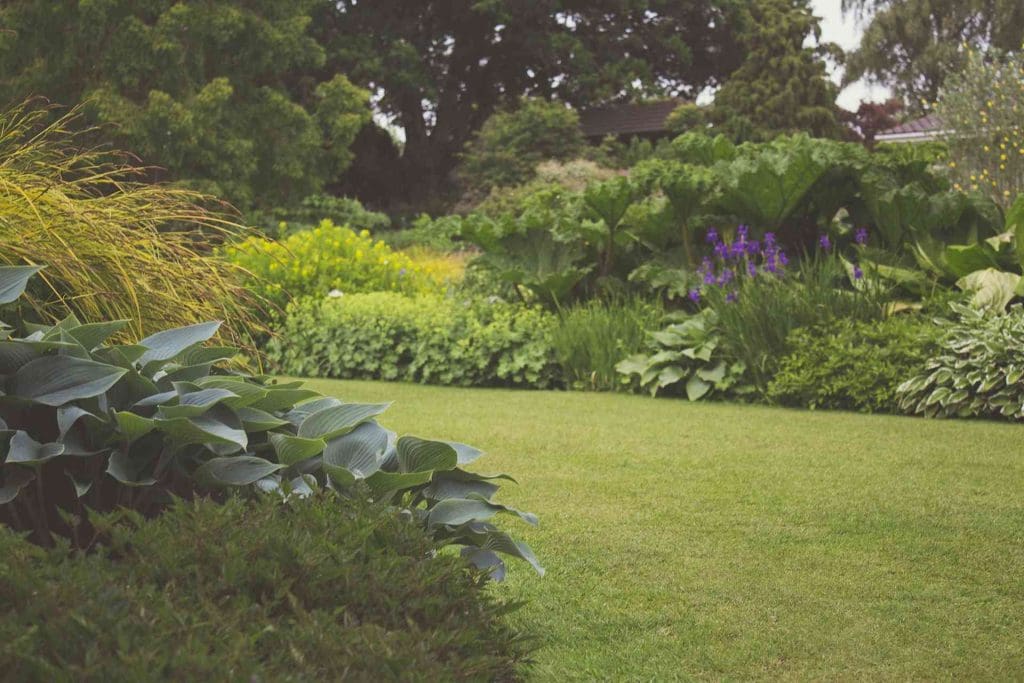Every now and then, we find ourselves staring at the neighbours’ lawns, pondering about how they got it to that condition in the first place. Did they invest huge amounts of time, effort and money into making it the envy of the street, it did they just enlist some nifty tips to keep maintenance on track? It’s most likely they embarked on ensuring they kept up with the staples of lawn care from day one, allowing them to create the look that you’re now lusting after.
There is good news, though. Achieving this doesn’t have to be a huge hassle. Just like your neighbours, keeping a few good habits in tow will help you to craft a healthy, well-maintained lawn that will soon become the envy of your other neighbours. No more mornings of strolled to the letterbox with coffee in hand, and glimpsing over the fence at something you wish you had…
The top tips you need to know about maintaining and growing a healthy lawn
Above all else, lawns only grow properly when they’re kept pruned back. Think of your rose bushes – without proper trimming and pruning, they quickly become unruly and wild. Grass is much the same, and without a care, they’ll also become riddled with weeds and pest plants. So, it goes without saying that grabbing out the mower every odd weekend is definitely on your to-do list, if you want to create the dream look you’re after.
How often do you really need to mow your lawn?
By letting your grass overgrown, you’ll create unwanted attention, but beyond that, you’ll damage the integrity of your lawn’s overall health. Sticking to a proper mowing schedule is the first step to really making sure its all kept in the best possible condition. How much you choose to kick-start your mower will depend on what time of year it is and if rainfall is frequent. If you’re getting a lot of sunshine, you’ll also need to keep an eye on how much it is growing.
Unfortunately, and especially in Australia, the weather can be unpredictable, making a solidified schedule a little bit more challenging to nail down. Instead, keep tabs on how your grass is growing and map out your week from there. If it looks like rain and sunshine have caused a growth spurt, it’s likely you’ll need to put in the time and effort before it gets out of hand in another week or so.
Mowing your lawn according to seasons
As a general rule of thumb, you can typically give your lawn a trim according to this seasonal cycle:
In summer: mow every fortnight
In autumn or winter: Mow once every 2-5 weeks
In spring: Mow every 2-4 weeks.
How high should you let your grass get?
How much you let your grass grow will require you to take it’s ‘species’ or variety into consideration. Beyond that, as stated before, seasons also play a part. Combining all of this together will keep you busy with understanding what makes your grass flourish the most. Additionally, if it’s not currently in the best condition, and you’re trying to initiate a bit of a revival process, it definitely won’t go through any rapid spurts of growth anytime soon.
However, to get at least some kind of plan of attack in place, it’s recommended you do not mow more than one-third of your lawn off each time. If you do, you run the risk of stripping the grass from its natural nutrients – something it needs to grow sufficiently. On the opposite side of the spectrum, letting it get too out of hand can also stop those nourishing sunshine rays and water from getting to the roots and bottom layers. So, here’s where you’ll need to balance out these two aspects.
Watering your lawn and keeping it hydrated
Like anything that’s alive, it needs water – and grass is no exception. However, there is a popular misconception that you need to water your lawn each and every day. When summer has kicked in, giving your grass a bit more of a drenching at least twice a week is enough to keep it lush. But if you’re experiencing a dry patch and rain isn’t blessing your area, you may need to add more of a soaking every now and then to keep it all from drying out.

When colder months have set in, watering doesn’t need to be as intense and is even needed (usually) unless a dry spell comes around. In actual fact, over-watering your lawn can cause disease to kick in – something which can be hard to bring a lawn back from.
No matter the season though, pay attention to how it’s all looking. Your judgement will often matter the most. If it looks like it’s begging for a drop of water, give it some – but don’t over-water. If it’s looking like it’s probably had too much, lay off the hose and let nature do its thing for a little bit. Just keep up with your mowing schedule to make sure you’re on track for a healthy, lush, envy-inducing lawn.
What time of day should you water your grass?
If you see your neighbours getting out the hose in the evenings, there’s a reason for it. At this time of day, there’s less of a chance that evaporation will occur, and it will minimise the amount of water you may lose through it. In essence, it gives you the best shot at hydration. Just the same, dishing out lots of water on a scorching-hot day means you’re allowing for it to boil the grass – something you definitely want to keep away from doing.
The importance of aeration
Just like water is essential for optimal growth, aeration is equally as crucial. In a nutshell, the soil under the areas of your lawn can become compacted, making it hard for the roots of the grass to penetrate the surface and breathe. Nutrients and water then struggle to reach the depths of the soil where roots are growing.
Compaction usually arises in worn areas that get a lot of foot traffic – be it from people or pets – and you’ll first notice dead patches starting to arise. Fixing it, though, is straight-forward. Experts can take a rake to the area (or garden fork/spiked lawn roller) and some other essentials to then remove all of the dead material that’s causing a blockage. If you’re not sure where to start, Jim’s Mowing team can help you eradicate this issue.
How to know what species of grass you have
In Australia, there are many types of grass varieties available on the market, and identifying them isn’t actually too hard to do. Some of the most common species include:
Soft-Leaf Buffalo: usually includes a larger, broader leaf blade. This one is a highly durable species that’s easy to grow and maintain, and newer forms of it are often soft to touch. It also has a good tolerance to shade and is primarily weed resistant.
Zoysia: including a fine leaf blade, this species is wider than some but tapers towards the tip of each blade. It also has quite a dense growth rate, making it fairly resistant to daily wear and tear. You’ll also find it has a good tolerance to shade and drought – added bonuses that are always handy to have.
Hybrid Bermuda: this fine leaf variety grows quickly and is significantly invasive. If you’re okay with having a species that requires more maintenance than others, it’s definitely the first choice for sporting surfaces. This is mostly because it deals well with being cut short. Add to that its drought and wear resistance and you’ve got a lot to reap in way of benefits here.
Couch: an extremely fine leaf species, Couch species are quick to grow but also highly invasive. They need lots of mowing but also act well as a sporting green, just like Bermuda varieties.
Kikuyu: featuring a medium leaf width, this blade is of a soft, bright green and absolutely loves the sun. However, it can be quite invasive, but does give you the benefit of an economical solution. Note that you’ll need to dish out maintenance more often than other types.
Fescue: highly frost-intolerant, this one is a deep green blend that does well in cooler seasons or areas. They’re typically slower to get up and running, but once it is, it’s a non-invasive option that is an all-round winner across the year. Note that you may need to water more often than other species in this list.
Seeds vs. buying readily available turf
If your yard needs a significant makeover, investing in already grown turf is sometimes the more economical and convenient option. But this will also depend on the variety you’re opting for and the amount of water it will need once it’s set in place. Using the above list will help you determine which form you should buy as a seed, versus as ready-to-install grass. And when in doubt, make sure you ask your local supplier or the Jim’s Mowing team for advice.
Above all else, if you are going along the route of seeds, remember that planting them at the right time of year is crucial. In Australia, spring is the best time to initiate new grass, generally because the weather isn’t too cold or too hot. This will give your seeds the best chance at growing without any disruptions caused by unpredictable weather patterns (such as those you get in summer or winter).
Understanding fertilisers
Just like keeping plants healthy, fertilisers are crucial for keeping any type of lawn healthy. Think of humans: we require a balance of nutrients in order to flourish. Grass is no different. Without investing in fertiliser, you’re keeping your lawn from the diet it needs.
The right type of fertiliser will depend on the variety of your grass and the demands it has. High-maintenance versions may need more specific nutrients, while others are more lenient. In essence, this is a form of food for your lawn, and feeding it too much will cause issues, just as too little will starve it. If you’re looking to give more T.L.C to your grass, handing out fertiliser should always be high on your list of priorities.
So, to help you get started on choosing the right type, here’s a few handy tips to keep in mind on when to fertilise your lawn:
- If you have pets around the house, look for green patches that are left by urine. As it contains Nitrogen – something grass doesn’t like – there’s often a “burnt” patch left behind as a result. If you see this, throw out some fertiliser to help it repair.
- If wind or rain have washed away nutrients, you’ll notice patches that have seen better days. Use this as a guide.
- Yellow grass that’s thinning out is a sign it’s typically gone into stress. This is usually the number one sign it needs a boost of nutrients.
- If you see clover starting to invade your lawn, this is also a tell-tale indication that your lawn is struggling to grow and outweigh this weed.
How to apply fertiliser
There’s some extreme methods you can use to properly fertilise your lawn, but unless you’re an expert or professional, they’re not always necessary. These often include taking soil samples and testing tissue to ensure the balance is what it should be. But if you’re not keen to do all of those hard yards, simply create a healthy mix of organic and synthetic fertilisers ever six or so weeks, and your lawn should reap the benefits. Remember, though, to always read the label for dosage requirements.
Using mulch or clippings
In addition to fertiliser, mulch can help provide added nutrients to your lawn. The best part is that it’s usually very affordable and you can even use your own lawn clippings to do the trick. If you’re keen to employ this shortcut, assess whether your mower has a mulching component attached, which allows you to redistribute these clippings back into your grass. From here, they’re reabsorbed by the soil and replenishes the balance of nutrients needed for a healthy growth spurt.
How to control weeds and disease
If you’ve got a lush lawn that’s starting to look the part, but it’s riddled with weeds and unsightly invaders, then you’re still not quite there. Luckily, it’s easy enough to ward off these unruly pests, if you employ the right tactics. So, here are a few quick steps to help you keep those weeds at bay:
- Regularly mulch your garden will stop weeds from getting the light they need to flourish. Mulch is also great for allowing those tiny insects and bugs to come around more often – they love to nibble on weed seeds, so they’re always a welcome visitor.
- Remove any weeds that pop up from their roots. This will stop them from growing back entirely.
- Avoid watering the weeds at all. Just like all other plants, they need sun and water, so it goes without saying that starving them of these elements will halt their growth.
How to spot a disease in your lawn
Lawns are susceptible to diseases and in Australia, there are a few common forms that tend to crop up. If you spot them early enough, they’re fairly simple to tackle, but you need to make sure you get on top of the problem before significant damage occurs. A few common diseases and their appearances include:
- Anthracnose: reddish-brown and yellow grass.
- Fusarium Patch: warm-brown grass.
- Brown Patch: round patches of brown grass.
- Fairy Ring: round patches of wilted or dead grass. Mushrooms may be apparent.
- Powdery Mildew: grass that is covered in a white-coloured powder.
If you happen to spot any of these signs, or something doesn’t seem quite right, we highly recommend contacting a professional (like those in our team) immediately. Experts can then assess the problem at hand and apply the right form of treatment to resolve it quickly.
Knowing whether you need pest control
Leaving your grass untreated means you give way to bugs and pests who can give tremendous damage over time. Spotting the issue and treating it as quickly as you can will minimise these impacts. If you’re not sure if these critters are calling your lawn home, watch out for the following signs:
- Birds digging at your grass constantly. This can cause problems and is often a sign that bugs are in the soil below.
- Some bugs eat the roots of the grass, leaving your lawn to become patchy and slowly die out. If you see these areas popping up, assess the issue immediately.
- Mounds of soil indicate ant nests, and while these are natural, they can stop your grass from growing (not to mention they can also give you a nasty bite).
Using pesticides to treat the problem
Designed to eliminate bugs and pests, pesticides seem like a good idea at first, but can often cause more harm than good. There’s a number of options on the market today, but most are created with chemicals that are toxic to lawns, pets and even children. If you’re considering using a pesticide to treat your grass, make sure you do your research first and understand what to stay clear of.
Investing in organic solutions
Sometimes organic lawn care can optimise the soil more than other forms of treatments can. While professional farms have long employed this route to improve their own crops, it’s now a popular tactic used by households across Australia, too. This is because organic options act as the perfect alternative to chemical-based pesticides.
Benefits of using organic solutions include:
A healthy lawn that has the ideal mix of nutrients, giving it the best shot at warding off invaders, pests and diseases.
- The perfect environment without any toxic chemicals or pesticides around.
- The opportunity to save money and time by providing your grass with exactly what it needs to keep healthy.
When professional lawn experts are required
Creating the perfect lawn that has your neighbours’ heads turning is a challenge. You’ll need to have the time and energy to keep up with maintenance and be savvy with the species of grass that you’ve got growing on your property. With all the fertilisation needs and pest elimination you’ll need to tackle, sometimes enlisting the help of an expert is the easiest path to take. The team at Jim’s Mowing are equipped with all the qualifications and knowledge to ensure your grass gets the best shot at success, eradicating any threats that pose a risk along the way.
If you’re not sure where to start, or feel overwhelmed with the amount of information you need to take in, let our professionals take care of the hard yards for you. Call us now on 1300 260 785 to get started.




